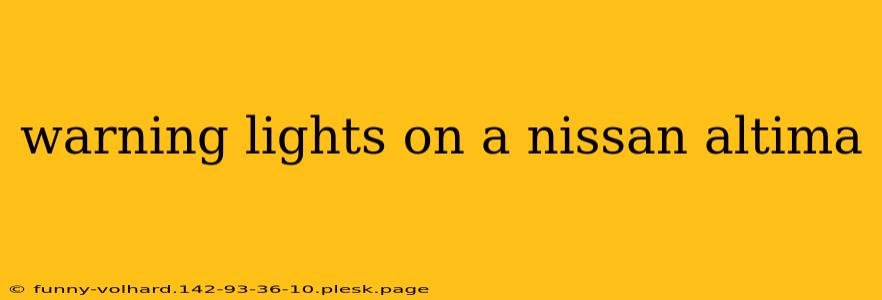Seeing a warning light illuminate on your Nissan Altima's dashboard can be unsettling. This comprehensive guide will help you decipher the meaning of those warning lights, understand their severity, and know what actions to take. We'll cover common warning lights, their potential causes, and when you should seek professional help.
Common Nissan Altima Warning Lights and Their Meanings
Your Nissan Altima's dashboard is equipped with various warning lights, each indicating a specific system issue. Ignoring these lights can lead to more significant problems and potentially dangerous driving situations. Here's a breakdown of some of the most frequently encountered warning lights:
Engine Warning Light (Check Engine Light)
This is arguably the most common warning light and typically depicted as a stylized engine. It illuminates when the car's onboard diagnostic system (OBD-II) detects a problem within the engine or emission control system. Causes can range from a loose gas cap to more serious issues like a failing catalytic converter or sensor malfunction. While not always an immediate emergency, it requires attention. A diagnostic scan from a mechanic is recommended to pinpoint the exact cause.
Battery Warning Light
This light, often shaped like a battery, indicates a problem with your car's charging system. Possible causes include a failing alternator, weak battery, or loose battery connections. If this light stays on, your battery might not be charging properly, potentially leaving you stranded. Immediate attention is advised.
Oil Pressure Warning Light
This light, usually depicted as an oil can with a drop of oil, is a serious warning. It signifies low oil pressure, which can lead to catastrophic engine damage if ignored. Low oil pressure can result from insufficient oil, a faulty oil pump, or a leak in the system. Pull over immediately and have your oil level and pressure checked. Driving with this light illuminated could severely damage your engine.
Brake System Warning Light
This light, usually showing a circle with an exclamation point inside, indicates a problem with your braking system. Potential causes include low brake fluid, a malfunctioning brake system component, or a parking brake issue. This warrants immediate attention. Do not drive until the issue is resolved.
Airbag Warning Light
This light usually shows a person sitting in a seat with a safety belt and airbag deploying. It indicates a problem with the airbag system. Malfunctioning airbags can compromise your safety in a collision. While not always immediately dangerous, it requires professional diagnosis and repair.
Tire Pressure Monitoring System (TPMS) Warning Light
This light displays a tire with an exclamation point inside. It indicates that one or more of your tires has low pressure. Low tire pressure can affect handling, fuel efficiency, and tire wear. Check your tire pressure and inflate as needed. If the light remains on after inflation, a tire puncture or leak may be present.
When to Seek Professional Help
While some warning lights might seem minor, it's always best to err on the side of caution. Seek professional help from a qualified mechanic if:
- The warning light remains illuminated after addressing potential simple issues (like adding oil or checking tire pressure).
- The warning light is accompanied by unusual sounds, smells, or performance issues.
- You are unsure of the meaning of a specific warning light.
Regular maintenance, including oil changes and inspections, can help prevent many of these issues from arising. By understanding your Nissan Altima's warning lights, you can ensure your safety and the longevity of your vehicle.

